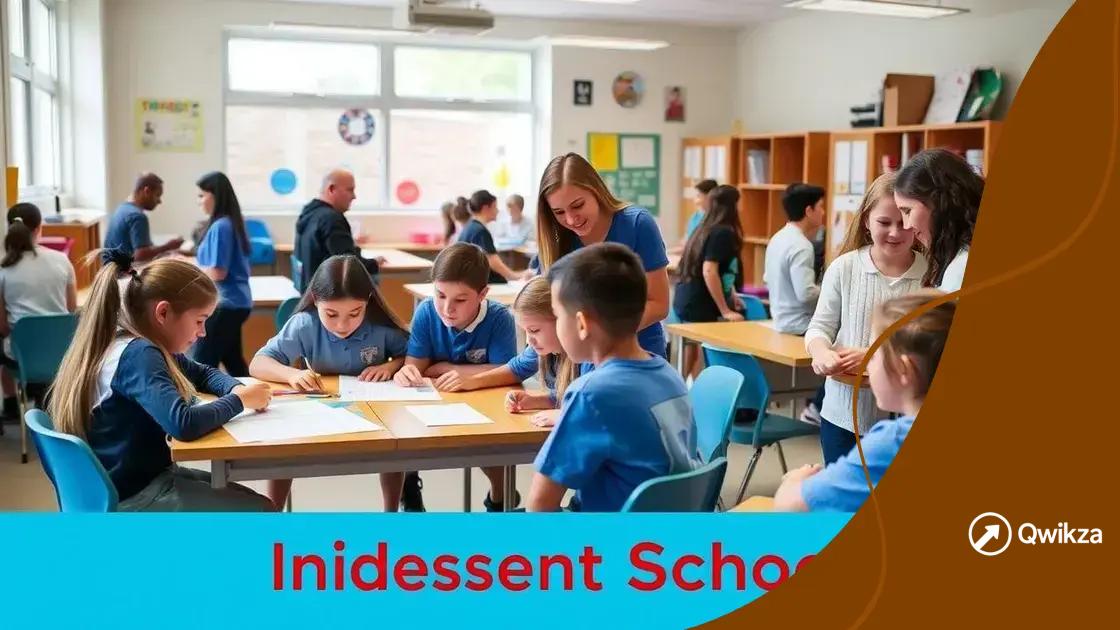Independent school comparisons: what parents need to know

Independent school comparisons involve evaluating factors like academic performance, curriculum offerings, extracurricular activities, and school culture to help families find the best fit for their children’s education.
When considering independent school comparisons, parents often find themselves navigating a sea of options. What truly sets these schools apart? From academics to extracurriculars, making an informed choice can impact your child’s future.
Understanding independent schools
Understanding independent schools is essential for parents looking for the best education for their children. These schools offer a unique set of benefits and challenges, distinctive from public institutions.
What are independent schools?
Independent schools are privately funded and managed. They have the flexibility to create their own curriculum and policies. This independence allows them to focus on individualized education and diverse teaching methods.
Key characteristics of independent schools
- Smaller class sizes, fostering closer teacher-student relationships
- A wide range of extracurricular activities, enhancing student engagement
- Emphasis on strong academic standards and innovative teaching
- Opportunities for personalized learning experiences
Many families choose independent schools for the high-quality education and supportive environments they provide. Parents often appreciate the values and missions that these schools uphold.
The admissions process for independent schools can be competitive and may require testing or interviews. It’s crucial for parents to be prepared and understand the requirements involved.
Benefits of attending an independent school
Students at independent schools often experience greater academic rigor and personalized attention. These institutions can offer unique programs, including arts, sports, and advanced placement courses, that might not be available in public schools.
Moreover, independent schools typically have strong community ties and often emphasize character education. This focus helps to develop well-rounded individuals who are ready for future challenges.
Lastly, independent schools have a distinct culture that promotes diversity and inclusivity, making them appealing to a wide range of families seeking a comprehensive educational environment.
Key factors in school comparisons
When making school comparisons, several key factors come into play. Understanding these elements helps parents choose the best school for their children.
Academic Performance
The academic performance of a school is one of the most important criteria. Parents should look at standardized test scores, college acceptance rates, and overall graduation rates. These metrics provide insights into the school’s effectiveness in preparing students for future challenges.
Curriculum and Programs
A diverse curriculum is crucial. Independent schools often offer unique programs, such as arts, sciences, and advanced placement courses. Parents should consider the opportunities for enrichment and how the curriculum aligns with their child’s interests.
- Academic rigor: Schools with challenging curriculums prepare students for higher education.
- Extracurricular offerings: A variety of activities can enhance the school experience.
- Support services: Availability of counseling and academic support contributes to student well-being.
Another aspect to examine is the class size. Smaller classes often lead to more personalized attention, enabling teachers to cater to each student’s needs. It can also foster a community feel, where students feel more engaged.
School Culture and Values
The culture of a school matters too. This includes the values it promotes and the environment it cultivates. Families should consider whether the school’s mission aligns with their own. Some schools emphasize community involvement, while others may focus on academic achievement.
Lastly, it’s important to evaluate the facilities and resources available. Well-maintained spaces and updated technology contribute to a positive learning atmosphere. Visiting a school can give parents a first-hand look at these elements.
Benefits of independent education

The benefits of independent education are numerous and impactful for students. Families often choose independent schools for their ability to provide tailored educational experiences.
Personalized Learning
One major advantage is personalized learning. Independent schools often have smaller class sizes, which allows teachers to focus on each student’s individual strengths and challenges. This tailored approach can help students thrive academically and socially.
Diverse Extracurricular Activities
Independent schools typically offer a rich array of extracurricular activities. These can include sports, arts, and clubs that align with students’ interests.
- Sports programs: Many independent schools provide robust sports opportunities, enhancing teamwork and physical health.
- Art and music programs: Creative subjects may play a significant role in the curriculum, encouraging students to express themselves.
- Leadership and service opportunities: Students often engage in community service and leadership initiatives, promoting character development.
Another key benefit is the strong school culture. Independent schools frequently instill values of community involvement and diversity, encouraging students to engage with different perspectives and backgrounds. This focus on values can promote a more inclusive environment, where all students feel respected and valued.
Academic Excellence
Moreover, independent schools often emphasize academic excellence. They typically maintain high academic standards, which prepares students for college and beyond. Students may have access to advanced placement courses and tailored support for college applications, increasing their readiness for higher education.
A supportive learning environment is also crucial. Independent schools encourage strong relationships between teachers, parents, and students, allowing for collaborative efforts that benefit the student’s experience. This partnership often results in a holistic approach to education, addressing not just academic needs but emotional and social growth as well.
How to evaluate independent schools
Evaluating independent schools is a crucial step for parents seeking the best educational environment for their children. A thorough assessment can provide valuable insights into a school’s strengths and weaknesses.
Visit the School
One of the most effective ways to evaluate a school is to visit it in person. This allows parents to see the facilities, meet teachers, and observe the learning environment. During a visit, pay attention to how students and teachers interact, as well as the overall atmosphere.
Review Academic Offerings
Academic offerings are a critical component of school evaluation. Parents should inquire about the curriculum, including core subjects and elective courses.
- Are there advanced placement options or honors courses?
- What subjects are emphasized, such as STEM, arts, or foreign languages?
- How does the school support different learning styles?
Additionally, academic performance metrics can provide insight into the school’s effectiveness. Look for standardized test scores and graduation rates. These statistics can help gauge the school’s ability to prepare students for future educational challenges.
Assess Extracurricular Activities
Extracurricular activities play a significant role in a student’s experience. These can range from sports to clubs to arts programs. A well-rounded selection of activities can promote personal growth and community involvement.
Pay attention to how many students participate in these programs. High participation rates often indicate a vibrant school culture that encourages student engagement.
Talk to Current Students and Parents
Another effective evaluation method is to talk with current students and parents. They can offer firsthand experiences and insights into the school’s culture. Ask about their satisfaction with the school, the support they receive, and the overall environment.
Engaging with the community can reveal aspects of the school that official materials may not capture. This feedback can provide a well-rounded perspective.
Finally, consider how the school communicates with families. Open lines of communication show that the school values parent involvement and transparency. Look for regular updates, accessible staff, and opportunities for parent engagement.
Compiling a personalized school shortlist
Compiling a personalized school shortlist is an important step for parents when selecting the right independent school for their children. This process involves evaluating various factors that align with the family’s values and the child’s needs.
Identify Priorities
Begin by identifying the family’s priorities. Consider what aspects of education are most important. Some families prioritize academic excellence, while others may focus on extracurricular activities or a strong community feel.
Research Potential Schools
Researching potential schools is essential. Use online resources, attend school fairs, and read reviews to gather information about various options. Take note of schools that stand out based on the family’s priorities. Make a preliminary list of schools that seem promising.
- Look into each school’s curriculum and programs.
- Check their admissions process and requirements.
- Review their college placement statistics and alumni success stories.
In addition, consider community feedback. Speaking with other parents or reading parent forums can provide insights that may not be evident in official materials.
Visit Schools
Visiting schools on the shortlist is a crucial next step. During visits, observe the campus environment. Pay attention to the interactions between students and teachers, as well as the facilities available. This firsthand experience can provide valuable context for making the final decision.
Evaluate School Fit
After visits, assess how well each school aligns with the family’s priorities. List the pros and cons for each school based on observations and gathered information. It can be helpful to discuss these findings as a family to ensure that everyone’s voice is heard.
Finally, consider the school culture. How well does the school’s mission match the family’s values? A school that resonates with the family’s beliefs can often provide a more fulfilling educational experience.
FAQ – Frequently Asked Questions about Independent School Selection
What should I prioritize when choosing an independent school?
Identify what matters most to your family, such as academic excellence, extracurricular activities, or school culture.
How can I gather information about different schools?
Use online resources, read reviews, and attend school fairs to learn about potential options.
Is it important to visit schools before making a decision?
Yes, visiting schools allows you to observe the environment, interact with staff, and assess the overall atmosphere.
How can I evaluate the fit of a school for my child?
Consider how well the school’s values and offerings align with your child’s needs and interests, and discuss findings with your family.
